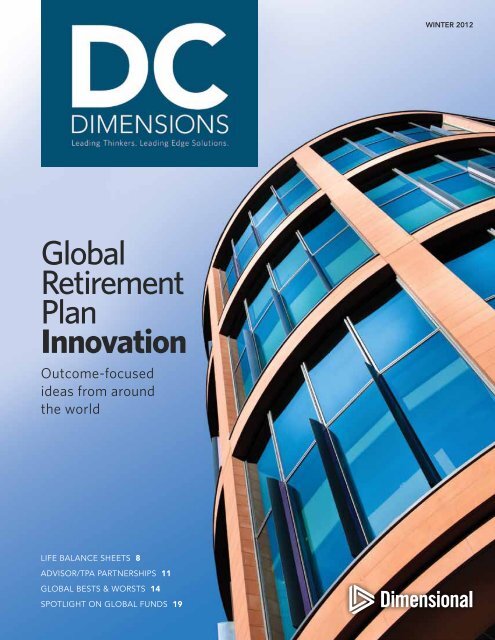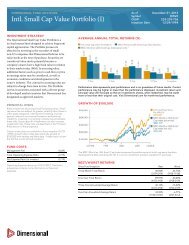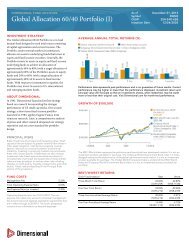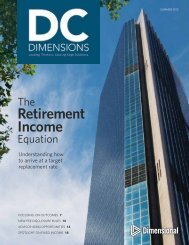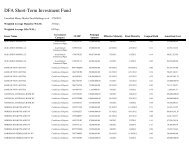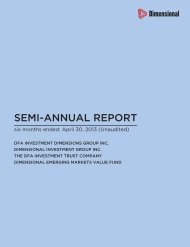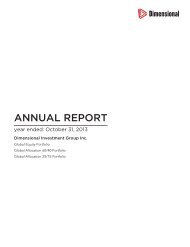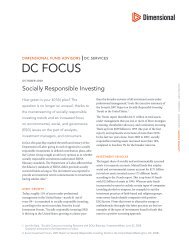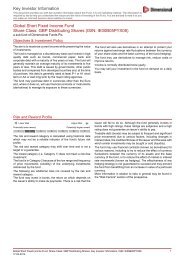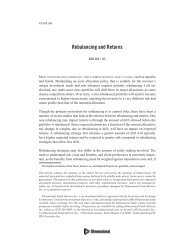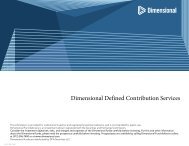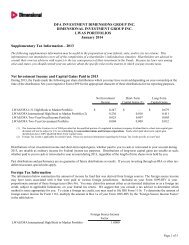Global Retirement Plan Innovation - Dimensional Fund Advisors
Global Retirement Plan Innovation - Dimensional Fund Advisors
Global Retirement Plan Innovation - Dimensional Fund Advisors
You also want an ePaper? Increase the reach of your titles
YUMPU automatically turns print PDFs into web optimized ePapers that Google loves.
<strong>Global</strong><br />
<strong>Retirement</strong><br />
<strong>Plan</strong><br />
<strong>Innovation</strong><br />
Outcome-focused<br />
ideas from around<br />
the world<br />
Life BaLance SheetS 8<br />
adviSor/tPa PartnerShiPS 11<br />
GLoBaL BeStS & WorStS 14<br />
SPotLiGht on GLoBaL fundS 19<br />
WINTeR 2012
DC DIMeNsIONs wInter 2012<br />
<strong>Global</strong> retirement<br />
<strong>Plan</strong> <strong>Innovation</strong> ...............2<br />
Legal Update .................6<br />
401(k) Spotlight ...............8<br />
ON THE COVER: <strong>Dimensional</strong>’s London Office<br />
<strong>Dimensional</strong> <strong>Fund</strong> <strong>Advisors</strong><br />
Palisades west<br />
6300 Bee Cave road, Building One<br />
Austin, tX 78746<br />
Phone: (512) 306-7400<br />
Fax: (512) 306-7499<br />
Advisor Focus ...............11<br />
<strong>Global</strong> DC. . . . . . . . . . . . . . . . . .14<br />
Academic Perspective ........16<br />
<strong>Dimensional</strong> Focus ..........19<br />
Fast Facts ..................20<br />
Upcoming DC events ........21<br />
the views and opinions of the third-party authors do not necessarily<br />
represent the views of <strong>Dimensional</strong> <strong>Fund</strong> <strong>Advisors</strong>.<br />
the articles are distributed for informational purposes only and should not be<br />
considered investment, tax, or legal advice or an offer of any security for sale.<br />
DC Dimensions is published for institutional and registered investment<br />
advisor use only. not for public use. <strong>Dimensional</strong> <strong>Fund</strong> <strong>Advisors</strong> LP is an<br />
investment advisor registered with the Securities and exchange Commission.<br />
Photo by Lee christiansen
Letter FrOM tHe eDItOr<br />
As we greet a new year with much-anticipated regulatory reforms, including a heightened<br />
awareness of fee disclosures, we want to shine a spotlight on the basics of retirement<br />
planning. In our second issue of DC Dimensions, we are pleased to feature an interview with<br />
Dr. Zvi Bodie of Boston University, who helps put into perspective how we can think about<br />
improving DC plan design. Focusing on the real risks faced by participants, Zvi offers a<br />
unique approach to solving today’s DC plan design problems.<br />
Many advances in retirement planning exist outside the US, so we think it makes sense<br />
to spend some time analyzing those offerings. In our cover story, we interview Malcolm<br />
Delahaye from Supertrust UK, a UK-based multi-employer plan. Malcolm explains his views<br />
on next generation retirement solutions and his process for evaluating these programs.<br />
we also head “down under” to talk with Dr. David Knox, a partner with Mercer’s risk and<br />
Consulting business, who shares highlights from recent research into the world’s best and<br />
worst retirement plans.<br />
For advisors, we feature a timely piece by <strong>Dimensional</strong> vice president Apollo Lupescu<br />
highlighting mutual opportunities that exist from partnerships formed by advisors and thirdparty<br />
administrators.<br />
we are also pleased to include an interview with the CFA Institute’s Stephen Horan, who<br />
explores the role of human capital in private wealth management, as well as an important<br />
legal/regulatory update from Ian Kopelman, chair of the DLA Piper LLP (US) employee<br />
Benefits and executive Compensation practice group and the <strong>Plan</strong> Sponsor Council of<br />
America (PSCA)’s legal counsel.<br />
Sincerely,<br />
TIM KOhN<br />
Head of DC Services and Vice President<br />
<strong>Dimensional</strong> <strong>Fund</strong> <strong>Advisors</strong><br />
tim.Kohn@dimensional.com<br />
wInter 2012 1
Malcolm Delahaye<br />
Director at SuperTrust UK<br />
<strong>Global</strong><br />
2 DC DIMenSIOnS
<strong>Retirement</strong> <strong>Plan</strong><br />
<strong>Innovation</strong><br />
Outcome-focused ideas from around the world<br />
By CUAtrO tOLSOn, regional Director, <strong>Dimensional</strong> <strong>Fund</strong> <strong>Advisors</strong><br />
Wwhen Malcolm Delahaye started his first job in Britain’s<br />
pension industry, the year was 1966. “I recall it vividly<br />
because it was the last time england won the FIFA world<br />
Cup,” Delahaye says with a laugh. “we’ve been waiting<br />
for another victory ever since.” while Britain’s days as<br />
world Cup champion may be long gone, the nation’s<br />
pension industry has moved quickly toward the future as<br />
employers continue to replace antiquated defined benefit<br />
plans with creative alternatives. >><br />
wInter 2012 3
“ It’s important for plan sponsors to shift their<br />
focus from savings to generating better<br />
outcomes for participants.”<br />
—Malcolm Delahaye<br />
In a career that has spanned more than forty-five<br />
years, Delahaye has witnessed tremendous changes<br />
in retirement plans, including the debut and debate<br />
about defined contribution versions. As DC plans<br />
continue to evolve, he believes it’s essential for plan<br />
sponsors to remember what they should ultimately<br />
deliver—a steady income in retirement. “DC plans<br />
involve savings products, so it’s tempting to view them<br />
as principally designed for saving,” Delahaye says.<br />
“However, I believe it’s important for plan sponsors<br />
to shift their focus from savings to generating better<br />
outcomes for participants.”<br />
while such a shift may require plan sponsors to<br />
embrace new solutions, the idea of income-based<br />
retirement planning is decidedly old-fashioned.<br />
“Pensions were originally designed to provide<br />
employees with a reliable source of income in<br />
retirement, rather than a lump-sum retirement benefit,”<br />
Delahaye says. “the goal was to help employees make<br />
a smooth transition from their working years to their<br />
retirement years while maintaining a similar quality of<br />
life after they stop working.”<br />
seTTINg The BAR hIgheR<br />
In 2005, Delahaye and his business partner Dennis Kemp<br />
launched Supertrust UK, providing DC plan solutions<br />
to employers worldwide. the firm’s flagship product,<br />
Supertrust UK, is a multi-employer retirement plan<br />
designed to help small to mid-size organizations benefit<br />
from the economies of scale enjoyed by larger plan<br />
sponsors. Delahaye believes that joining a multi-employer<br />
plan can be an effective way for growing businesses<br />
to meet their fiduciary obligations to employees while<br />
continuing to focus on their core competencies.<br />
FOCusINg ON ReTIReMeNT INCOMe<br />
Delahaye believes the next generation of retirement<br />
solutions will need to focus on annuity-style<br />
outcomes for plan participants—by helping them<br />
address both inflation and longevity risks more<br />
effectively. “while there are significant differences<br />
between DB and DC plans, both in terms of how<br />
the retirement plans are funded and who carries the<br />
risk, many of the fundamental investment strategies<br />
Lord hutton:<br />
Combine Best of DB & DC<br />
Lord John Hutton, who recently<br />
chaired Britain’s Independent Public<br />
Service Pensions Commission, is a<br />
vocal advocate for bringing the best<br />
elements of DB plans into DC plans.<br />
At the 2011 National Association of<br />
Pension <strong>Fund</strong>s conference, Hutton<br />
outlined three primary challenges that<br />
he believes are currently facing DC<br />
plan sponsors:<br />
• Guaranteeing a satisfactory<br />
income to plan participants.<br />
• Protecting that income against<br />
inflation.<br />
• Generating income that will<br />
potentially last for a participant’s<br />
lifetime.<br />
“ DC must<br />
do all of the<br />
heavy lifting<br />
as we try<br />
to reassure<br />
people<br />
about their<br />
standard<br />
of living in<br />
retirement.”<br />
–Lord<br />
Hutton<br />
4 DC DIMenSIOnS
and risk management techniques used in DB plans<br />
can be effectively transferred to DC plans,” he says.<br />
“we’re trying to bring participants the best of what<br />
DB plans have to offer.”<br />
As an early adopter of outcome-based retirement<br />
planning, Delahaye expects to see this approach<br />
gain more traction with employers as organizations<br />
continue to review and update their benefit plans.<br />
A changing regulatory environment in the US<br />
and abroad—one encouraging greater fiduciary<br />
responsibilities for plan sponsors—may be one of the<br />
catalysts bringing change to many retirement plans.<br />
“In my experience, employers often prefer to avoid<br />
MALCOLM DeLAhAye is a director of<br />
SuperTrust UK Pension Trustees Ltd., which is<br />
responsible for the operation of the SuperTrust<br />
UK Master Trust, a DC occupational scheme<br />
set up in 2005 for non-associated employers.<br />
Malcolm is also a fellow of the Pensions<br />
Management Institute (PMI). Previously, he was<br />
technical director at Godwins (now part of Aon<br />
Hewitt), pensions development manager at P&O,<br />
and pensions manager at Lend Lease. His trustee<br />
experience has included a position as a memberelected<br />
trustee and a trust company director.<br />
“ Ultimately, I expect to see employers worldwide<br />
becoming more actively engaged with their<br />
employees in the retirement planning process.”<br />
—Malcolm Delahaye<br />
making key decisions until the last minute. People<br />
need a catalyst for change,” Delahaye says.<br />
Helping plan participants do a better job of<br />
replacing income in retirement requires a new way<br />
of thinking, notes Delahaye. “employers can no<br />
longer afford to think of defined contribution plans<br />
as simply another cash benefit,” he says. “As a result,<br />
many employers may need to review their default<br />
investment options in the context of the potential<br />
they have to generate actual income in retirement.<br />
Ultimately, I expect to see employers worldwide<br />
becoming more actively engaged with their<br />
employees in the retirement planning process.” �<br />
wInter 2012 5
LegAL UPDAte<br />
MAnAGInG FIDUCIArY<br />
reSPOnSIBILItY<br />
How plan fiduciaries can enlist the help of an investment advisor<br />
By IAn KOPeLMAn, Partner at DLA Piper LLP (US) and PSCA’s Legal Counsel<br />
Pitfalls await 401(k)<br />
plan fiduciaries who<br />
assume that, under<br />
the employee<br />
retirement Income<br />
Security Act of 1974<br />
(erISA), they can<br />
eliminate their potential liability<br />
with respect to the plan’s<br />
investment options by retaining an<br />
outside investment advisor. the<br />
facts: erISA plan fiduciaries (e.g.,<br />
the sponsor, a committee, or<br />
another in-house fiduciary) are<br />
never fully relieved of fiduciary<br />
responsibility, even when an advisor<br />
assumes that responsibility for the<br />
investment of plan assets. However,<br />
retaining an outside advisor can<br />
help plan fiduciaries fulfill their<br />
responsibilities under erISA.<br />
A plan fiduciary has the duty to act:<br />
(1) solely in the interest of<br />
participants and beneficiaries and<br />
(2) for the exclusive purpose of<br />
benefiting participants and<br />
beneficiaries, and defraying<br />
reasonable expenses of<br />
administering the plan. Further,<br />
under erISA’s prudent man<br />
standards, fiduciaries must<br />
discharge their duties with “the<br />
care, skill, prudence, and diligence<br />
under the circumstances then<br />
prevailing that a prudent man<br />
acting in a like capacity and familiar<br />
with such matters would use in the<br />
conduct of an enterprise of a like<br />
character and with like aims.”<br />
translation: All fiduciary actions are<br />
measured against what someone<br />
who knows the area would do<br />
under the same circumstances. If a<br />
plan fiduciary does not know the<br />
area, prudence requires the<br />
fiduciary to get help from someone<br />
who does. Decisions concerning<br />
the investment options offered to<br />
plan participants are one area in<br />
which prudence may require the<br />
fiduciary to get expert help.<br />
Many plan fiduciaries are officers or<br />
other employees of the plan sponsor<br />
whose primary responsibilities do not<br />
require investment expertise. In other<br />
words, unlike an investment advisor,<br />
the average plan fiduciary is not a<br />
specialist in portfolio theory, financial<br />
analysis, or investment management<br />
and probably does not have the time<br />
to become one. An informed<br />
decision about the investment<br />
options offered to plan participants<br />
requires an analysis of information<br />
such as past performance and<br />
returns, fund volatility, fund<br />
managers, turnover, and fees. this<br />
process requires both time and<br />
expertise, which can be in short<br />
supply for the plan’s fiduciaries. An<br />
“ It may be advisable to get expert<br />
help—and it may be required.”<br />
— Ian Kopelman,<br />
PSCA’s Legal Counsel<br />
advisor has greater and faster access<br />
to relevant information regarding the<br />
plan’s investment options. As a result,<br />
an advisor’s analysis is likely to be<br />
more exact, and the investment<br />
options that are eventually selected<br />
may be more in line with the<br />
investment goals of the plan and<br />
participants. thus, it may be<br />
advisable to get expert help, and<br />
according to Department of Labor<br />
regulations, it is actually required:<br />
“Unless they possess the necessary<br />
expertise . . . fiduciaries would need<br />
6 DC DIMenSIOnS
to obtain the advice of a qualified,<br />
independent expert.”<br />
An independent investment advisor<br />
hired by retirement plan fiduciaries<br />
may or may not accept fiduciary<br />
status with respect to the plan, but<br />
in either case, the in-house plan<br />
fiduciaries retain fiduciary<br />
responsibility for selecting,<br />
retaining, or replacing investment<br />
options offered to participants.<br />
Both the selection of investment<br />
options and the selection of the<br />
investment advisor are subject to<br />
erISA’s prudence requirement.<br />
If a plan’s in-house fiduciaries<br />
choose to hire an advisor to<br />
assume fiduciary responsibility for<br />
the plan’s investment options, and<br />
to select and monitor them, the<br />
erISA prudence requirement<br />
applies to the decision to<br />
delegate investment discretion<br />
responsibility and to the selection<br />
of the investment advisor.<br />
regardless of the goal in hiring<br />
an investment advisor, the<br />
selection (and retention or<br />
replacement) of the advisor is, on<br />
its own, a fiduciary decision that<br />
must satisfy the erISA prudence<br />
standard. General considerations<br />
for this selection include the<br />
following:<br />
• Experience with other similar<br />
plans and investments, education<br />
credentials, registration with<br />
appropriate regulatory<br />
authorities, reputation, and<br />
references.<br />
• Level of service, including<br />
quality, suitability for the type of<br />
plan and the participant<br />
population, and value of<br />
services relative to fees.<br />
• Independence, particularly in<br />
light of the expert’s compensation<br />
and the potential for any<br />
prohibited transactions.<br />
• Fees and expenses (both<br />
investment-related fees and the<br />
expert’s fees), competitiveness,<br />
and reasonableness.<br />
Finally, documenting prudence in<br />
the selection of an advisor requires<br />
plan fiduciaries to maintain files with<br />
the information collected and<br />
reviewed in the decision-making<br />
process, and to keep a record of the<br />
analysis of the information and the<br />
reasons for their decision. If the<br />
fiduciaries are members of a<br />
committee, minutes of the meeting<br />
in which a selection was made—<br />
including the number of candidates<br />
considered—will provide this record.<br />
Otherwise, a memorandum to the<br />
file listing the same information can<br />
serve the same purpose. �<br />
Excerpted and adapted from the<br />
September/October 2011 Defined<br />
Contributions Insights magazine, published<br />
by the <strong>Plan</strong> Sponsor Council of America.<br />
wInter 2012 7
401(K) SPOtLIGHt<br />
FrOM MY COrner<br />
CFA Institute’s Stephen Horan speaks out on the need for<br />
defined contribution plans to address the life balance sheet<br />
concept, human capital, longevity risk, and more<br />
By tODD erSKIne, regional Director,<br />
and DerrICK AMeY, Senior Associate, <strong>Dimensional</strong> <strong>Fund</strong> <strong>Advisors</strong><br />
sTepheN hORAN, PhD, CFA, CIPM, leads university outreach efforts and<br />
supports the development of private wealth management initiatives at CFA<br />
Institute. He has authored or coauthored several books, including The New<br />
Wealth Management: A Financial Advisers Guide to Managing and Investing<br />
Client Assets. Prior to joining CFA Institute, he was a professor of finance at<br />
St. Bonaventure University, principal of Alesco <strong>Advisors</strong> LLC, and a financial<br />
analyst and forensic economist in private practice. He serves on the editorial board of the<br />
Journal of Wealth Management and the Financial Services Review.<br />
DC Dimensions: Stephen, you’ve<br />
written that wealth managers can<br />
learn from defined benefit pension<br />
fund managers by applying asset/<br />
liability management techniques<br />
to managing investments. Can you<br />
start by giving us an overview of<br />
how a life balance sheet concept<br />
and discretionary wealth can be<br />
applied to help participants in<br />
defined contribution (DC) plans<br />
manage their own investments?<br />
stephen horan: the life balance<br />
sheet concept takes a more<br />
comprehensive view of assets than<br />
simply assets that show up on your<br />
account statement. we want to<br />
be thinking more broadly about<br />
human capital, the value we derive<br />
from other retirement plans, Social<br />
Security, and other tangible assets,<br />
such as real estate, etc. taking a<br />
broader view of our assets is the<br />
first step to understanding the life<br />
balance sheet.<br />
Second, we want to understand<br />
and appreciate a person’s assets<br />
within the context of liabilities by<br />
thinking about liabilities not just<br />
in terms of the mortgage on the<br />
house but in terms of what our<br />
investment goals are. that can be<br />
an unintuitive way to think about<br />
things because we’re trained to<br />
think about our investment goals<br />
as a good thing. the reality is that<br />
meeting our investment goals<br />
requires funding. those goals<br />
represent cash outflows. that’s the<br />
definition of a liability.<br />
DC Dimensions: How would you<br />
define human capital? what are<br />
some of the risks to human capital?<br />
horan: Strictly speaking, human<br />
capital can be thought of as the<br />
after-tax, actuarial present value of<br />
our earnings—after tax because we<br />
can’t spend what we earn before<br />
those taxes are taken out, actuarial<br />
because there is uncertainty around<br />
how long we will work and in what<br />
capacity we will work, and present<br />
value because those cash flows<br />
will accrue over time. we don’t get<br />
them all at once. But the common<br />
denominator is that human capital<br />
is tied to our earnings.<br />
DC Dimensions: So everyone’s<br />
human capital can be different, and<br />
8 DC DIMenSIOnS
ased on your profession, you can<br />
have very different risk embedded<br />
in your human capital?<br />
horan: In terms of magnitude,<br />
it’s surprisingly large for most<br />
people. In the US, human capital<br />
represents over 50% of individuals’<br />
assets on a life balance sheet, even<br />
up until their 50s, and that includes<br />
accounting for the value of their<br />
house or their private business.<br />
Ignoring such a sizable asset<br />
on the balance sheet really can<br />
cause us to make under-informed<br />
investment decisions.<br />
there are three significant risks to<br />
human capital. One is what I would<br />
call a liquidity or a marketability<br />
risk. It is not an asset that we can<br />
call up our broker and sell today<br />
and liquidate. these are cash flows<br />
that need to be realized over time.<br />
related is the second risk, which<br />
is mortality or even disability.<br />
Unforeseen circumstances, even<br />
if they’re low probability, can<br />
interrupt an earnings stream.<br />
the third risk is asset concentration<br />
or sector risk. If I’ve got one asset<br />
that is very heavily weighted in my<br />
portfolio, I run the risk of having an<br />
overly concentrated portfolio.<br />
DC Dimensions: Can you<br />
determine an individual’s risk<br />
tolerance using this life balance<br />
sheet concept?<br />
horan: An individual’s risk tolerance<br />
will depend on his or her<br />
discretionary wealth—that is, the<br />
amount by which assets exceed<br />
liabilities. this surplus is a buffer for<br />
investment risk. For example, if my<br />
assets are four times as large as my<br />
discretionary wealth, a 10% drop in<br />
asset value will decrease<br />
discretionary wealth by 40%. So the<br />
less cushion you have, the more<br />
implied leverage there is on a life<br />
balance sheet. If there’s more<br />
leverage on the balance sheet, it<br />
means I’m less risk-tolerant with<br />
respect to those assets on the<br />
balance sheet.<br />
DC Dimensions: So discretionary<br />
wealth is what’s left over after you<br />
have accounted for your highpriority<br />
goals (such as retirement),<br />
and those goals are liabilities on<br />
the life balance sheet?<br />
horan: If everything is a high<br />
priority, that means you’re going to<br />
have far too little surplus (or perhaps<br />
even a deficit), and it means you’re<br />
really not very risk-tolerant. If, on the<br />
other hand, you can prioritize your<br />
goals so not everything is highest<br />
priority, you’ve got more surplus on<br />
your balance sheet because your<br />
liabilities aren’t as large and you can<br />
tolerate more risk.<br />
DC Dimensions: How can we<br />
get DC plan participants to think<br />
about the difference between asset<br />
and liability values, their required<br />
income at retirement, the concept<br />
of human capital, and this life<br />
balance sheet concept as opposed<br />
to wealth accumulation?<br />
horan: the best way I know to get<br />
people to think about asset/liability<br />
management is to get them focused<br />
on the surplus or the discretionary<br />
wealth. this sometimes reveals a<br />
dark reality. Often people define a<br />
minimum required income that is<br />
larger than the assets they have<br />
available to fund it. In other words,<br />
their surplus is negative. that’s a<br />
very common circumstance, even<br />
though people don’t typically go<br />
through the analysis to reveal it.<br />
the way people most commonly<br />
address this is by putting capital at<br />
risk in the hopes of earning a higher<br />
return. that can be dangerous taken<br />
to an extreme. taking more risk with<br />
your assets does not decrease the<br />
size of the liabilities.<br />
DC Dimensions: How can a DC<br />
plan participant deal with longevity<br />
risk, and how can it be factored into<br />
the participant’s investment plan?<br />
horan: there are two ways to deal<br />
with longevity risk. First, build up<br />
precautionary savings, by which I<br />
mean build up enough capital and<br />
enough resources so that you’ve<br />
self-insured. regardless of how<br />
long you’ll live, you’re going to<br />
have enough capital, but it is<br />
expensive and not necessarily<br />
efficient to build up that much<br />
capital. the second way is to insure<br />
it. If you’re going to insure it, the<br />
two principal ways would be<br />
through a traditional fixed annuity<br />
or a deferred annuity, sometimes<br />
called longevity annuities.<br />
If I buy a fixed annuity, the insurance<br />
company is going to turn around<br />
relatively quickly and start giving me<br />
checks. those near-term checks are<br />
wInter 2012 9
cash flows that are not at all<br />
difficult for the individual to<br />
replicate on his own. what’s<br />
difficult for individuals to do by<br />
themselves is to create the cash<br />
flow in the out years that’s<br />
contingent on their lifespan. the<br />
deferred annuity concentrates with<br />
the insurance company the risk<br />
that they’re most able to efficiently<br />
LIFE BALANCE SHEET EXAMPLE<br />
intermediate for. the deferred<br />
annuity just gets rid of the earlyyear<br />
cash flows that the investors<br />
can more easily take care of<br />
themselves.<br />
DC Dimensions: Do you see a way<br />
to apply this life balance sheet<br />
concept to manage DC investments<br />
on a larger scale?<br />
The life balance sheet is a comprehensive accounting of an investor’s assets,<br />
liabilities, and net worth—including human capital and all expected cash flows<br />
from DB pensions and Social Security. The left side of the balance sheet lists a<br />
client’s traditional financial assets, tangible assets, and implied assets. The right<br />
side includes liabilities secured by tangible assets as well as implied liabilities tied<br />
to investment goals. Leverage measures the investor's sensitivity to risk.<br />
PORTION %<br />
100<br />
80<br />
60<br />
40<br />
20<br />
0<br />
HOUSE<br />
OTHER STOCK<br />
COMPANY STOCK<br />
COMPANY STOCK OPTIONS<br />
NET EMPLOYMENT CAPITAL<br />
$2,800,000<br />
LEVERAGE=2.8<br />
MORTGAGE<br />
COLLEGE<br />
RETIREMENT<br />
DISCRETIONARY WEALTH<br />
ASSETS LIABILITIES AND EQUITIES<br />
Copyright (2011), Research Foundation of CFA Institue. Reproduced and republished from The New<br />
Wealth Management with permission from the Research Foundation of CFA Institue. All rights reserved.<br />
horan: Yes, it definitely creates a<br />
framework whereby we can call into<br />
question the appropriateness of<br />
company stock as an investment<br />
option in DC plans. the life balance<br />
sheet illustrates how heavily<br />
exposed most people are to their<br />
employment. Additional company<br />
stock exacerbates that already<br />
excessive concentration.<br />
the industry could also consider<br />
developing a product that actually<br />
accounts for the commonality of<br />
human capital risks of participants in a<br />
particular DC plan. Suppose I manage<br />
a plan for the participants in the auto<br />
industry. Participants have their human<br />
capital tied to industrial production<br />
and somewhat tied to interest rates. In<br />
theory, they would want an investment<br />
portfolio that doesn’t expose them<br />
further to some of those common<br />
risks. All participants are unique, but<br />
employees of the same firm have<br />
some common exposure. So, one<br />
could imagine a DC plan-specific<br />
product that’s designed to carve out,<br />
if you will, a completion portfolio<br />
tailored to those participants’ risk<br />
exposures.<br />
It’s possible to develop a completion<br />
fund for DC plan participants, but it’s<br />
only going to be an approximate<br />
solution. It’s difficult to create a truly<br />
customized solution based on things<br />
that vary so much from individual to<br />
individual and are predicated on so<br />
much measurement error.<br />
Developing a customized solution<br />
that takes into account each individual<br />
participant’s life balance sheet could<br />
improve investment outcomes and<br />
benefit DC plan participants. �<br />
10 DC DIMenSIOnS<br />
$1,800,000 $1,000,000
ADvIsOR FOCUS<br />
MUtUAL OPPOrtUnItIeS<br />
In DeVeLOPInG ADVISOr/tPA<br />
PArtnerSHIPS<br />
By APOLLO D. LUPeSCU, Vice President,<br />
<strong>Dimensional</strong> <strong>Fund</strong> <strong>Advisors</strong><br />
A widely used<br />
business strategy for<br />
financial advisors<br />
who work with<br />
individual investors<br />
is to establish<br />
relationships with<br />
centers of influence, particularly CPA<br />
firms. these strategic partnerships<br />
engender benefits for all parties<br />
involved: Clients receive a more<br />
comprehensive set of services, and<br />
advisors and CPA firms develop a<br />
new referral source that leads to<br />
business growth while significantly<br />
increasing their competitiveness.<br />
A relatively untapped extension of<br />
this strategy is to build strong<br />
partnerships with third-party<br />
administrators (tPAs) that can<br />
benefit advisors engaged in 401(k)<br />
business, as well as the tPA firms.<br />
to be sure, some of the several<br />
thousand qualified tPAs across the<br />
US already offer investment services<br />
(“producing tPAs”), but many<br />
others do not generate revenue<br />
from investment services. without<br />
investment advisory services, the<br />
latter group might be at a<br />
competitive disadvantage relative to<br />
firms with a more comprehensive<br />
solution, and they may fail to<br />
capture a potential revenue source<br />
at a time when their services have<br />
become commoditized in a “race to<br />
the bottom” for fees. recent actions<br />
by some large providers to<br />
disengage independent tPA<br />
services have added urgency,<br />
leaving plan administrators in a<br />
vulnerable position with fewer<br />
referrals and slower growth.<br />
As former president of the American<br />
Society of Pension Professionals &<br />
Actuaries (ASPPA), Sarah<br />
Simoneaux, principal of Simoneaux<br />
and Stroud Consulting Services, is in<br />
a unique position to provide insight<br />
on this emerging partnership<br />
opportunity. She believes<br />
independent advisors and tPAs<br />
should develop a new partnership<br />
paradigm that benefits nonproducing<br />
tPAs and gives advisors<br />
an opportunity to engage new<br />
prospects, including “orphan” plans<br />
likely to be created by the recent fee<br />
disclosure regulations. “the vast<br />
majority of tPAs provide very<br />
“ the vast majority of tPAs provide<br />
very high-quality services that<br />
are frequently undervalued by<br />
advisors and plan sponsors.”<br />
— Sarah Simoneaux,<br />
Principal of Simoneaux and Stroud Consulting Services<br />
high-quality services that are<br />
frequently undervalued by advisors<br />
and plan sponsors,” she says,<br />
adding that tPAs would like to see a<br />
more balanced compensation<br />
model that would motivate referring<br />
401(k) business to the advisor.<br />
In her opinion, advisor/tPA<br />
partnerships are not more prevalent<br />
wInter 2012 11
due to three factors:<br />
commoditization of tPA services,<br />
misconceptions of advisor/tPA roles<br />
and compensation in servicing plans,<br />
and the complexity and cost of<br />
government regulations. traditionally,<br />
the advisor in the small and mid-size<br />
employer 401(k) market has<br />
controlled the plan sponsor<br />
relationship, bringing in the tPA as a<br />
commodity provider as just one part<br />
of the overall qualified plan sale.<br />
“tPAs often feel they do the majority<br />
of the plans’ servicing work for low<br />
fees (especially compared to assetbased<br />
fees frequently paid to<br />
advisors) and that neither the plan<br />
sponsor nor the advisor appreciates<br />
their role in keeping the plan in<br />
compliance,” Simoneux says.<br />
“<strong>Advisors</strong> believe they’re held<br />
responsible for tPA administrative<br />
errors or service gaps and can lose<br />
401(k) business as a result. the truth,<br />
as always, is somewhere in between.<br />
the most successful partnerships<br />
exist when the advisor understands<br />
the complexity of plan design and<br />
administration, and the tPA values<br />
the advisor’s role in working with the<br />
investments and the participants.”<br />
Successfully building these<br />
connections is not trivial. <strong>Advisors</strong><br />
must identify the right firms to<br />
mitigate the reputational risk if the<br />
tPA can’t provide the level of service<br />
expected by the plan sponsor and<br />
participants. tPAs must balance the<br />
risk of losing referrals from advisors<br />
who might see them as competitors<br />
with the opportunity to strengthen<br />
their business and develop an<br />
economically sustainable model.<br />
Simoneaux believes both risks can<br />
be mitigated by a well thought-out<br />
business plan for the partnership,<br />
with clearly defined goals and<br />
objectives, a sales and marketing<br />
strategy, and metrics to measure<br />
success. Furthermore, she says<br />
location and matching firm<br />
“personalities” are major factors in a<br />
strong, mutually beneficial<br />
relationship, one in which both<br />
parties provide true fee transparency<br />
to the employer and participants.<br />
Personal referrals from satisfied plan<br />
sponsors and other advisors,<br />
especially for local providers, are still<br />
a good, traditional way for advisors<br />
to identify quality service providers.<br />
Simoneux also suggests using the<br />
ASPPA service provider certification<br />
(http://www.asppa.org), a process<br />
that requires tPAs to go through a<br />
rigorous, independent best<br />
practices audit annually in order to<br />
obtain and renew their certification.<br />
High-quality tPAs should be able to<br />
show that close to 100% of their<br />
senior-level administrators hold<br />
either ASPPA or nIPA (national<br />
Institute of Pension Administrators)<br />
“ the most successful partnerships exist when the<br />
advisor understands the complexity of plan<br />
design and administration, and the tPA values<br />
the advisor’s role in working with the investments<br />
and the plan participants.”<br />
— Sarah Simoneaux,<br />
Principal of Simoneaux and Stroud Consulting Services<br />
credentials. excellent tPAs will also<br />
have measurable service metrics,<br />
not just statements about providing<br />
high-quality services.<br />
Although it is more complex to keep<br />
track of multiple partners,<br />
Simoneaux suggests that advisors<br />
develop good relationships with two<br />
to three tPAs. At least one partner<br />
should be a local provider who can<br />
go onsite to local employers’<br />
offices. Another partner should have<br />
the ability to do open-architecture<br />
daily valuation recordkeeping. A<br />
third partner should be considered<br />
for specialty plan designs such as<br />
cash balance plans, eSOPs, and<br />
403(b)/457 plans. �<br />
12 DC DIMenSIOnS
<strong>Dimensional</strong> <strong>Fund</strong> <strong>Advisors</strong>’<br />
London office lobby.<br />
wInter 2012 13
gLOBAL DC<br />
InSIGHtFUL LeSSOnS FrOM<br />
ArOUnD tHe wOrLD<br />
A global expert grades the best and worst retirement plans<br />
By tIM KOHn, Head of DC Services and Vice President,<br />
<strong>Dimensional</strong> <strong>Fund</strong> <strong>Advisors</strong><br />
DAvID KNOx, Phd, a senior partner at Mercer australia, is the author of the<br />
Melbourne Mercer <strong>Global</strong> Pension index, a report that objectively assesses the<br />
retirement income systems in sixteen countries spread across the americas,<br />
europe, and asia Pacific. he is also the national leader for research and actuary<br />
for the victorian and tasmanian governments and the Western australian public<br />
sector pension plan, and was the industry expert on a three-person team that<br />
conducted a review of the australian military superannuation program. he is currently chair of<br />
australia’s aSfa retirement outcomes committee.<br />
with life expectancy increasing<br />
and financial turmoil spreading,<br />
providing sustainable retirement<br />
benefits is not just a US dilemma.<br />
retirement systems around the<br />
world are facing—and meeting—<br />
similar challenges. to glean some<br />
important lessons from other<br />
countries, we spoke with Dr. David<br />
Knox, author of the Melbourne<br />
Mercer <strong>Global</strong> Pension Index.<br />
DC Dimensions: In looking at<br />
global retirement systems, what<br />
are the most common challenges<br />
facing the architects?<br />
David Knox: the biggest and<br />
most common challenge relates<br />
to the world’s aging population,<br />
a population of people who will<br />
need resources in their retirement<br />
years. <strong>Global</strong>ly, we are very<br />
likely to see a few important<br />
changes as people live longer<br />
than ever before. First, we are<br />
going to have to work longer<br />
before retiring, and second, we<br />
are going to have to save more.<br />
Governments around the world<br />
will also increase the age retirees<br />
start to draw on their retirement<br />
benefits, and reforms to pension<br />
systems will increase coverage<br />
and contribution rates.<br />
DC Dimensions: the Melbourne<br />
Mercer <strong>Global</strong> Pension Index<br />
ranks the netherlands as one of<br />
the best retirement systems in the<br />
world, a position it seems to be<br />
sustaining even as other systems<br />
lose ground. what exactly makes<br />
the Dutch system so good?<br />
Knox: the Dutch system is not<br />
perfect. we rank it a B-plus and<br />
note that it is still going through a<br />
reform process. Key to the success<br />
of the system is that coverage is<br />
very good. Virtually everybody<br />
who is an employee is covered by<br />
the pension system. the system<br />
does not rely solely on government<br />
funding. It’s also a fairly mature<br />
system. Finally, when you take into<br />
consideration the regulation and<br />
governance requirements in the<br />
netherlands, the system performs<br />
very well there too.<br />
DC Dimensions: Your analysis<br />
ranks the US as middle of the<br />
road, or a grade C, meaning<br />
a system with major risks and<br />
shortcomings. what can be done<br />
to improve our system?<br />
14 DC DIMenSIOnS
MeLBOuRNe MeRCeR gLOBAL peNsION INDex 2011<br />
The Melbourne Mercer <strong>Global</strong> Pension<br />
Index assesses the retirement income<br />
systems in sixteen countries spread<br />
across the Americas, Europe, and Asia<br />
Pacific (see chart). No country’s system<br />
has an index value above 80, which<br />
represents an A grade. However, six<br />
countries have an index value between<br />
65 and 80, which represents a B grade.<br />
With some adjustments or improvements,<br />
these countries could be re-classified as<br />
A-grade systems.<br />
Knox: One of the things is to<br />
broaden the coverage of the private<br />
pension system. where the US falls<br />
down is that less than half of the<br />
private-sector employees have any<br />
membership in a pension system.<br />
there is good coverage in the<br />
public sector, some coverage in the<br />
private sector (but mainly with larger<br />
employers), and very little coverage<br />
in some sectors of the workforce.<br />
the other factor we need to bear<br />
in mind is that this money should<br />
be used for retirement. In the<br />
US, there’s some leakage in the<br />
system. Some people tend to draw<br />
down on their retirement savings<br />
for other purposes, which means<br />
when they come to retirement,<br />
it’s not always as much as it might<br />
otherwise have been.<br />
Country<br />
Netherlands<br />
Australia<br />
Sweden<br />
Switzerland<br />
Canada<br />
UK<br />
Chile<br />
Poland<br />
Brazil<br />
US<br />
Singapore<br />
France<br />
Germany<br />
Japan<br />
India<br />
China<br />
Average<br />
Ranking<br />
DC Dimensions: what can private<br />
employers do to improve outcomes<br />
for their DC participants?<br />
Knox: Private employers<br />
can improve the level of<br />
communication to their<br />
participants. As an example, most<br />
participants will get a statement<br />
showing their account balance<br />
every year. If I have a $20,000<br />
balance, what does that mean?<br />
will this number grow to $100,000<br />
or $200,000? In addition, can we<br />
express this projected benefit as<br />
an income stream? we’ve got to<br />
start thinking in terms of income<br />
streams and give participants<br />
information that will engage them.<br />
And I should note that this is not<br />
just a US phenomenon. In brief,<br />
plan sponsors need to change<br />
the discussion and change their<br />
vocabulary to encourage greater<br />
engagement.<br />
DC Dimensions: we hear a lot<br />
about next generation DC programs.<br />
what are the necessary attributes<br />
of the next generation of defined<br />
contribution products and services?<br />
Knox: engagement and<br />
communication is just one part of<br />
next generation programs. the<br />
second fundamental component<br />
is to ensure portability. Finally,<br />
we need appropriate defaults.<br />
that means when people don’t<br />
do anything because they’re<br />
disengaged, they still have a good<br />
outcome. And those outcomes<br />
should target an income stream in<br />
their retirement years. �<br />
wInter 2012 15<br />
2011<br />
1<br />
2<br />
3<br />
4<br />
5<br />
6<br />
7<br />
8<br />
9<br />
10<br />
11<br />
12<br />
13<br />
14<br />
15<br />
16<br />
2010<br />
1<br />
4<br />
3<br />
2<br />
5<br />
6<br />
7<br />
–<br />
8<br />
10<br />
9<br />
11<br />
12<br />
13<br />
–<br />
14<br />
Overall<br />
Index Value<br />
Grade<br />
77.9<br />
B+<br />
75.0<br />
B+<br />
73.4<br />
B<br />
72.7<br />
B<br />
69.1<br />
B<br />
66.0<br />
B<br />
64.9<br />
C+<br />
58.6<br />
C<br />
58.4<br />
C<br />
58.1<br />
C<br />
56.7<br />
C<br />
54.4<br />
C<br />
54.2<br />
C<br />
43.9<br />
D<br />
43.4<br />
D<br />
42.5<br />
D<br />
60.6 C+
ACADeMIC PerSPeCtIVe<br />
tHe CUrrent StAte OF neXt<br />
GenerAtIOn PLAn DeSIGn<br />
By tIM KOHn, Head of DC Services and Vice President, <strong>Dimensional</strong> <strong>Fund</strong> <strong>Advisors</strong><br />
ZvI BODIe is a finance professor at Boston university. he holds a Phd from the<br />
Massachusetts institute of technology and is coauthor (with alex Kane and alan<br />
Marcus) of the widely used textbook Investments. his textbook Financial Economics<br />
is coauthored by nobel laureate robert c. Merton, resident scientist at dimensional<br />
fund advisors. dr. Bodie’s latest book, written with rachelle taqqu, cfa, is Risk<br />
Less and Prosper: Your Guide to Safer Investing.<br />
the 2006 Pension Protection Act<br />
(PPA) created some of the most<br />
sweeping changes in pension<br />
legislation since the original<br />
employee retirement Income<br />
Security Act (erISA) of 1974. Five<br />
years later, the PPA continues to<br />
redefine the defined contribution<br />
(DC) plan landscape, offering the<br />
opportunity for continued and<br />
important innovation in retirement<br />
plan design.<br />
today, the focus of much thought<br />
and debate is on how to produce<br />
better retirement outcomes—<br />
ideally transforming an industry<br />
centered on savings to one<br />
focused on providing retirement<br />
income. that means innovation<br />
should address some of the<br />
structural flaws found in widely<br />
used default investments—<br />
qualified default investment<br />
alternatives (QDIAs)—which are<br />
typically asset allocation funds such<br />
as target-date funds. Unfortunately,<br />
almost all widely used QDIAs do<br />
not properly address the income<br />
needs of current or future retirees.<br />
On the positive side, the current<br />
state of plan design is a marked<br />
improvement over the previous<br />
paradigm. Coupled with the<br />
PPA’s allowance for automatic<br />
enrollment and automatic<br />
escalation of participant<br />
deferrals, target-date funds do<br />
take into account the failure of<br />
plan participants to proactively<br />
manage their retirement savings<br />
and they do offer adequate risk<br />
diversification. Just as balanced<br />
funds were an improvement over<br />
investing in a single stand-alone<br />
fund, target-date funds combine<br />
the basics of behavioral economics<br />
and offer a pre-set asset allocation<br />
glide path. However, much more<br />
can be done.<br />
By focusing solely on asset<br />
allocation, target-date funds<br />
fail to take into account<br />
participants’ unique demographic<br />
differences (including human<br />
capital, gender, income levels,<br />
supplemental savings, and<br />
spousal demographics) as well as<br />
the fundamental issue facing all<br />
retirees: how much money can<br />
be used on a monthly basis to<br />
cover spending needs. Bottom<br />
line: today’s QDIAs don’t offer<br />
what participants need the most—<br />
monthly income in retirement.<br />
Here, Zvi Bodie, PhD, professor of<br />
finance and economics at Boston<br />
University School of Management,<br />
discusses the challenges facing<br />
today’s plan sponsors as they<br />
struggle to provide complete<br />
benefits packages that not only<br />
satisfy current regulations, but also<br />
help to better prepare retirees for<br />
the challenges of retirement.<br />
DC Dimensions: what are the<br />
top risks facing both individuals<br />
16 DC DIMenSIOnS
and plan sponsors in the current<br />
retirement landscape?<br />
Zvi Bodie: For plan participants,<br />
it’s risks to their standard of living<br />
or income throughout life. the<br />
resulting investment challenge is<br />
to transfer income or resources<br />
from the period in life when one<br />
earns the most to the period in<br />
life when one earns a lot less.<br />
A risk under the DC system is<br />
any disability that could affect a<br />
participant’s ability to work and<br />
therefore save. this is not only<br />
true for the participant but also<br />
for a participant’s spouse. there<br />
are a lot of people in their 50s<br />
with no desire to retire who are<br />
finding out that they’re having<br />
to retire a lot earlier than they<br />
thought they would have due to<br />
family disability.<br />
with respect to plan sponsors, the<br />
major impediment and the major<br />
defect in a lot of plans is relying on<br />
the fallacious idea that stocks are<br />
going to do the heavy lifting, that<br />
as long as the participant’s money<br />
is invested—a large fraction of<br />
it in the stock market—then you<br />
can count on a high rate of return.<br />
Stocks are risky in the short run,<br />
and they’re risky in the long run.<br />
DC Dimensions: what can plan<br />
sponsors do now to better prepare<br />
their workforce for retirement?<br />
Bodie: there are a lot of things<br />
plan sponsors can do. It starts with<br />
basic education about financial<br />
fitness and the importance of<br />
getting out of debt. For a lot of<br />
people, that is one of the biggest<br />
challenges to saving. In terms<br />
of building up a nest egg, I just<br />
finished a book with rachelle<br />
taqqu called Risk Less and Prosper:<br />
Your Guide to Safer Investing. the<br />
basic idea, contrary to what a lot<br />
of the conventional wisdom says<br />
about saving for retirement, is<br />
that you have to first and foremost<br />
worry about your basic needs.<br />
You need to target a minimum<br />
income level in retirement. Once<br />
participants have covered their<br />
minimum income levels, they<br />
can take on more risk in order<br />
to achieve a potentially higher<br />
income stream. this message<br />
needs to be delivered to plan<br />
participants through plan sponsor<br />
communication and education<br />
programs, and/or be incorporated<br />
by next generation defaults.<br />
DC Dimensions: Speaking of<br />
defaults, what aspects should a<br />
default option have in order to<br />
better prepare plan participants<br />
for retirement?<br />
Bodie: A good default option<br />
is tailored to an individual plan<br />
participant and his or her particular<br />
circumstances. we need defaults<br />
that combine the best features of<br />
both defined benefit and defined<br />
contribution programs. In other<br />
words, the default should offer<br />
defined benefit-like protection on<br />
the downside, offer a minimum<br />
guarantee, and be professionally<br />
managed. Combining the best<br />
of DC, the solution should allow<br />
customization, portability, and<br />
upside potential.<br />
Zvi Bodie Coming<br />
to a City Near you<br />
<strong>Dimensional</strong> <strong>Fund</strong> <strong>Advisors</strong> is<br />
partnering with Zvi Bodie to offer<br />
a unique educational conference<br />
series designed for plan sponsors,<br />
consultants, and advisors.<br />
Zvi will discuss plan design, next<br />
generation retirement incomeoriented<br />
defaults, and investment<br />
lineups, and also deliver a primer on<br />
human capital and risk. <strong>Dimensional</strong><br />
will offer sessions on ERISA’s decisionmaking<br />
framework, selecting and<br />
monitoring service providers, and<br />
creating a compliant policy statement.<br />
CFA Institute has approved this<br />
ERISA Fiduciary Training Program,<br />
sponsored by PSCA, for six<br />
continuing education credit hours,<br />
inclusive of one hour in content<br />
areas of Standards, Ethics, and<br />
Regulations (SER). CE credit for<br />
this program will be automatically<br />
recorded in your CE Diary if you<br />
are a CFA Institute member.<br />
Dates:<br />
March 22<br />
Dallas<br />
July 26<br />
Boston<br />
August 23<br />
San Francisco<br />
November 8<br />
New York<br />
Registration details:<br />
Please check your mail in early February,<br />
contact your <strong>Dimensional</strong> regional<br />
director, or sign up online at:<br />
http://dfaus.com/zvibodie<br />
wInter 2012 17
DC Dimensions: It seems like<br />
target-date funds have filled the<br />
“QDIA of choice” default since<br />
2006 as the dominant savings<br />
vehicle for participants. what<br />
is the biggest shortcoming of<br />
today’s target-date funds?<br />
Bodie: the biggest shortcoming<br />
is that there’s no income level<br />
being targeted. the target-date<br />
fund simply promises a certain<br />
mix of inputs of the portfolio<br />
composition. <strong>Plan</strong> participants<br />
don’t care about the inputs; they<br />
care about the outcomes. the<br />
term that’s used in connection<br />
with a target-date fund is a<br />
“glide path,” which actually is<br />
an apt analogy that brings to<br />
mind a flight plan. How are you<br />
going to get from where you<br />
are now to where you want to<br />
be at retirement? the current<br />
generation of target-date funds<br />
just tells you an expected time of<br />
arrival. It just doesn’t say where<br />
you’re going—that’s one hell of<br />
a flight plan! Participants need<br />
a certain destination—at least a<br />
certain minimum level of standard<br />
of living in retirement.<br />
As I think of what happened<br />
during 2008, when many targetdate<br />
funds lost 30–40% of their<br />
value for plan participants<br />
who were about to retire, I am<br />
encouraged to know that many<br />
retirement plan sponsors are<br />
now rethinking their approach<br />
to their current default options.<br />
next generation default options<br />
need to offer a safe landing at<br />
plan participants’ target date,<br />
minimum income levels, and<br />
fundamentals of both DB and DC,<br />
and they need to accomplish this<br />
at a reasonable cost.<br />
“ Participants in defined<br />
contribution plans don’t care<br />
about the inputs; they care<br />
about the outcomes.”<br />
— Zvi Bodie, Professor of Finance at Boston University<br />
DC Dimensions: You said, “the<br />
plan participant really can’t do<br />
it alone.” who else has a role in<br />
helping participants achieve their<br />
retirement targets?<br />
Bodie: the employee benefits<br />
department can have a<br />
tremendous impact on participant<br />
outcomes in the US. through<br />
basic plan design, the employer<br />
can help close the retirement<br />
income gap. we used to think<br />
that this was in large part the<br />
government’s role, but we’re now<br />
seeing that people are being<br />
asked to do it on their own. An<br />
employer can provide a very<br />
valuable gatekeeping function in<br />
this new retirement paradigm.<br />
DC Dimensions: Looking to<br />
retirement systems outside the US,<br />
are there any lessons to be learned<br />
that may help inform our readers?<br />
Bodie: the Dutch have one of<br />
the best retirement systems in<br />
the world. However, it’s also not<br />
sustainable in its current form<br />
because it has promised too much.<br />
the Dutch have to find ways of<br />
lowering the level of guaranteed<br />
benefits (or quasi-guaranteed<br />
benefits) and shift more of the risk<br />
to the participants. I imagine their<br />
system will look more like ours in<br />
the future.<br />
Australia and new Zealand<br />
have done the best job so far in<br />
providing free, objective online<br />
education to participants, but<br />
that type of education only takes<br />
you so far. even if you get people<br />
to pay attention, there’s still<br />
the problem of getting them to<br />
implement. education alone, no<br />
matter how well it’s done, is never<br />
the complete solution. �<br />
_______________________________<br />
reAD MOre OnLIne<br />
Find out more about the Dutch<br />
system in a recent paper by Zvi Bodie<br />
and Henriette Prast, titled “rational<br />
Pensions for Irrational People: Behavioral<br />
Science Lessons for the netherlands,”<br />
on the <strong>Dimensional</strong><br />
DC Services website:<br />
http://dfaus.com/dutch<br />
18 DC DIMenSIOnS
DIMeNsIONAL FOCUS<br />
SPOtLIGHt On GLOBAL FUnDS<br />
By SteVe CLArK, Head of Portfolio Management,<br />
and CrAIG HOrVAtH, CFA, <strong>Global</strong> Head of Consultant relations, <strong>Dimensional</strong> <strong>Fund</strong> <strong>Advisors</strong><br />
<strong>Dimensional</strong>’s global fund-of-funds<br />
portfolios are designed to help<br />
investors with different risk tolerances<br />
achieve their long-term investment<br />
goals. the portfolios can be a good<br />
choice for defined contribution plans.<br />
In many plans, a large proportion of<br />
DC participants may lack the time,<br />
discipline, or knowledge to manage<br />
a retirement investment portfolio.<br />
<strong>Dimensional</strong>’s global portfolios are<br />
managed by professionals trained in<br />
academic investment theory who<br />
select specific asset allocations to<br />
maintain proper diversification,<br />
monitor asset class performance, and<br />
rebalance the portfolios regularly.<br />
the underlying funds include bond<br />
<strong>Global</strong> Equity Portfolio<br />
Component <strong>Fund</strong>s<br />
US EQUITIES<br />
Core equity 1<br />
Core equity 2<br />
real estate<br />
NON-US EQUITIES<br />
International Core 1<br />
EMERGING MARKETS<br />
emerging Markets Core<br />
<strong>Global</strong> 60/40 Portfolio<br />
and/or stock funds that provide<br />
highly diversified exposure to<br />
thousands of securities across over<br />
forty countries.<br />
vALue-ADDeD AppROACh<br />
the portfolios benefit from the firm’s<br />
value-added asset allocation<br />
approach that is designed to<br />
maximize expected return for given<br />
levels of risk and enhance portfolio<br />
stability, all while keeping costs low.<br />
each global portfolio is built upon a<br />
specific combination of underlying<br />
funds (see chart). this modular<br />
structure affords maximum flexibility<br />
to efficiently target overall portfolio<br />
risk and adjust asset allocations.<br />
<strong>Global</strong> 25/75 Portfolio<br />
Component <strong>Fund</strong>s<br />
Component <strong>Fund</strong>s<br />
US EQUITIES<br />
US EQUITIES<br />
Core equity 1<br />
Core equity 1<br />
Core equity 2<br />
Core equity 2<br />
real estate<br />
real estate<br />
NON-US EQUITIES<br />
NON-US EQUITIES<br />
International Core 1<br />
International Core 1<br />
EMERGING MARKETS<br />
EMERGING MARKETS<br />
emerging Markets Core<br />
emerging Markets Core<br />
GLOBAL FIXED INCOME<br />
GLOBAL FIXED INCOME<br />
Short-term extended Quality<br />
two-Year <strong>Global</strong><br />
Five-Year <strong>Global</strong><br />
Inflation-Protected Securities<br />
Selectively Hedged <strong>Global</strong><br />
Inflation-Protected Securities<br />
Intermediate-term extended Quality<br />
Short-term extended Quality<br />
eQuITy COMpONeNTs<br />
the equity component of each<br />
global portfolio employs<br />
<strong>Dimensional</strong>’s core equity funds,<br />
allowing investors to achieve global<br />
asset class exposure in an efficient<br />
manner that minimizes turnover and<br />
transaction costs. the equity<br />
components focus on the small cap<br />
and value premiums in an effort to<br />
enhance expected returns.<br />
FIxeD INCOMe COMpONeNTs<br />
the fixed income components of the<br />
<strong>Global</strong> 60/40 and <strong>Global</strong> 25/75<br />
portfolios are carefully chosen to<br />
complement each portfolio’s equity<br />
allocation, helping optimize the<br />
tradeoff between dampening risk<br />
and maximizing expected return.<br />
QDIA<br />
For plan sponsors who have decided<br />
to use a balanced fund as a plan’s<br />
qualified default investment<br />
alternative (QDIA), certain<br />
<strong>Dimensional</strong> global portfolios may<br />
be the right choice. For more<br />
information, please contact your<br />
<strong>Dimensional</strong> regional director. �<br />
Performance of the global portfolios will depend on the performance of the underlying funds. risks of the funds also include loss of principal and fluctuating value.<br />
the international components involve special risks such as currency fluctuation and political instability. Investing in emerging markets may accentuate these risks.<br />
Sector-specific and small cap investments can also increase investment risks. Fixed income securities are subject to increased loss of principal during periods of<br />
rising interest rates. they are also subject to various other risks, including changes in credit quality, liquidity, prepayments, and other factors. the funds’ prospectuses<br />
further describe these risks in the Principal risks section. this information is provided for registered investment advisors and institutional investors, and is not<br />
intended for public use. <strong>Dimensional</strong> <strong>Fund</strong> <strong>Advisors</strong> LP is an investment advisor registered with the Securities and exchange Commission.<br />
Consider the investment objectives, risks, and charges and expenses of the <strong>Dimensional</strong> funds carefully before investing.<br />
For this and other information about the <strong>Dimensional</strong> funds, please read the prospectus carefully before investing.<br />
Prospectuses are available by calling <strong>Dimensional</strong> <strong>Fund</strong> <strong>Advisors</strong> collect at (512) 306-7400 or at www.dimensional.com.<br />
<strong>Dimensional</strong> funds are distributed by DFA Securities LLC.<br />
wInter 2012 19
FAsT FACtS<br />
OTHER<br />
RETIREMENT<br />
ASSETS<br />
$13.4 trillion<br />
DC PLAN<br />
ASSETS<br />
$4.7 trillion<br />
DC PLAN<br />
ASSETS represented<br />
more than one-quarter of<br />
the total retirement market<br />
and almost one-tenth of<br />
US households’ aggregate<br />
financial assets at the end of<br />
Q1 2011.<br />
62% OF PLAN SPONSORS<br />
Feel their responsibility includes taking an interest in whether<br />
employees are moving toward a comfortable retirement<br />
(i.e., replacement ratio).<br />
ONLY 15% of plan sponsors believe most<br />
employees will be prepared for retirement. 65% of plan sponsors<br />
offer a qualified default investment alternative (QDIA) for the<br />
automatic enrollment program.<br />
More than 65% of Fortune 100 companies’ DC plans offer<br />
between 11 and 20 INvesTMeNT OpTIONs.<br />
Over 71% of MODERATE INCOME<br />
($30,000–$50,000) workers covered by a workplace retirement<br />
plan participate in that plan, while only 4.6% of those<br />
employees not covered by a workplace retirement plan<br />
participate in a deductible IrA.<br />
MORE ThAN hALF<br />
(57%) of Americans in the lowest income quartile<br />
will run short of funds after 20 years in retirement.<br />
55%<br />
of plan participants prefer that a<br />
professional investment expert make<br />
decisions about how to invest money<br />
in their DC plan. 51% prefer to put their retirement nest egg<br />
in an account that manages how much is spent each year to<br />
ensure they do not run out of money.<br />
<strong>Plan</strong> sponsors report that about 40% of their participants<br />
expressed disappointment when their 2010<br />
TARGET-DATE FUNDS realized an average 30%<br />
loss in 2008. 61% of all plan sponsors indicated they were at least<br />
a little surprised when this loss occurred.<br />
Sources: ICI, Federal reserve Board, IrS Statistics of Income Division, Deloitte, towers watson, employee Benefits research Institute, Boston research Group.<br />
ABOUT DIMENSIONAL:<br />
now in its thirty-first year, <strong>Dimensional</strong> <strong>Fund</strong> <strong>Advisors</strong> is a global<br />
institutional asset management firm with around-the-clock trading<br />
capabilities out of offices in Austin, Santa Monica, London, and Sydney.<br />
the firm also has offices in Vancouver, Amsterdam, and Berlin.<br />
<strong>Dimensional</strong> acts as investment advisor, or sub-advisor, for hundreds of<br />
financial advisor and institutional clients, including corporate defined<br />
benefit and defined contribution plans, public retirement plans, family<br />
offices, financial institutions, endowments, and foundations. As of December<br />
2011, the firm managed about 250 investment vehicles and had approximately<br />
$214 billion in assets under management,<br />
including $15.6 billion in DC assets.<br />
20 DC DIMenSIOnS
upCOMINg DC eveNTs | 2012<br />
JAN<br />
FEB<br />
January 30–February 1 | Austin, TX<br />
DIMENSIONAL INSTITUTIONAL SYMPOSIUM<br />
February 16–17 | Austin, tX<br />
DIMENSIONAL ADvISOR<br />
AdvAncEd 410(k) SYMPOSIUM<br />
March 18–20 | new Orleans, LA<br />
ASPPA 401(k) SUMMIT<br />
March 18–21 | San Francisco, CA<br />
MID-SIZED RETIREMENT<br />
& HEAlTHcArE PlAn MAnAGEMEnT<br />
March 22 | Dallas, tX<br />
ZvI BODIE/DIMENSIONAL<br />
EDUCATIONAL SERIES<br />
sAve The DATe:<br />
Zvi Bodie/<br />
<strong>Dimensional</strong> <strong>Fund</strong><br />
<strong>Advisors</strong><br />
educational Series<br />
MAR<br />
March 22 Dallas, tX<br />
July 26 Boston, MA<br />
August 23 San Francisco, CA<br />
november 8 new York, nY<br />
Please check your mail in early February,<br />
contact your <strong>Dimensional</strong> regional director, or<br />
sign up online at: http://dfaus.com/zvibodie.<br />
May 23–24 | Chicago, IL<br />
diMEnSionAl AdviSor 401(k) WORkSHOP<br />
June 5–8 | Chicago, IL<br />
MID-SIZED RETIREMENT<br />
& HEAlTHcArE PlAn MAnAGEMEnT<br />
June 13 | Chicago, IL<br />
DIMENSIONAL ANNUAL DC CONFERENCE<br />
July 11–12 | Santa Monica, CA<br />
diMEnSionAl AdviSor 401(k) WORkSHOP<br />
July 15–18 | Seattle, wA<br />
WESTERN PENSION BENEFITS CONFERENCE<br />
July 26 | Boston, MA<br />
ZvI BODIE/DIMENSIONAL<br />
EDUCATIONAL SERIES<br />
<strong>Dimensional</strong>’s 2012<br />
Annual DC Conference<br />
Chicago Booth<br />
Gleacher Center<br />
June 13, 2012<br />
For conference materials for this event,<br />
information about <strong>Dimensional</strong>’s Annual<br />
Investment Symposium, or upcoming events,<br />
please visit us at http://dfaus.com/dc2012.<br />
wInter 2012 21<br />
MAY<br />
JUN<br />
JUL
Leading Thinkers. Leading Edge Solutions.<br />
CONTACT INFORMATION<br />
For more information about the<br />
services that <strong>Dimensional</strong> offers<br />
to defined contribution plan<br />
sponsors, consultants, and<br />
recordkeepers, please contact:<br />
TIM KOhN<br />
(512) 306-4939<br />
tim.kohn@dimensional.com<br />
If you are an investment advisor,<br />
please contact:<br />
AshIsh shResThA<br />
(310) 656-4211<br />
ashish.shrestha@dimensional.com<br />
<strong>Dimensional</strong>'s Resource for DC Professionals<br />
SLX 512: 01/12


